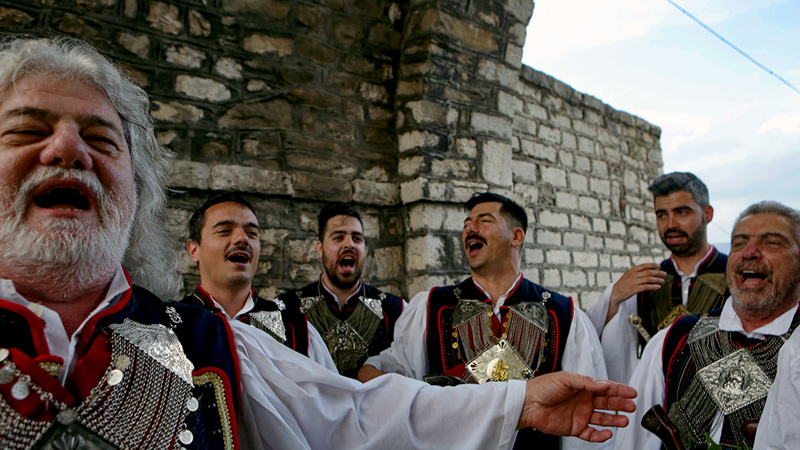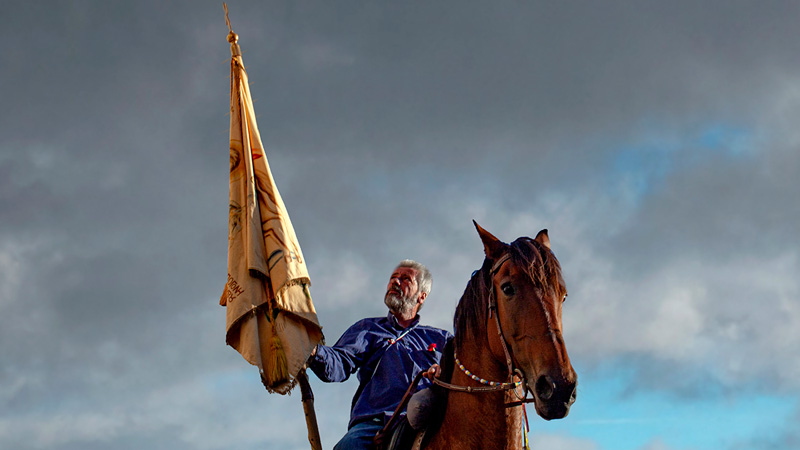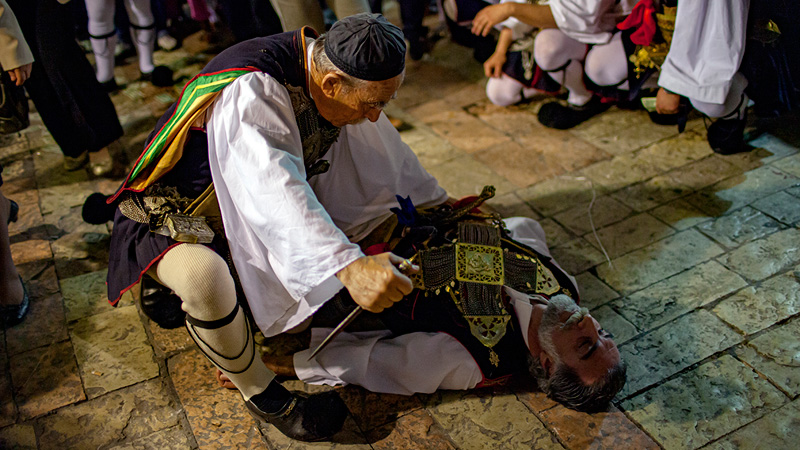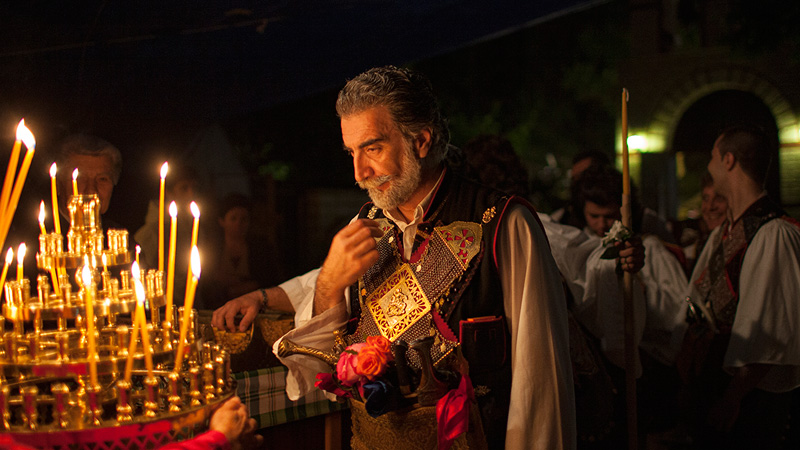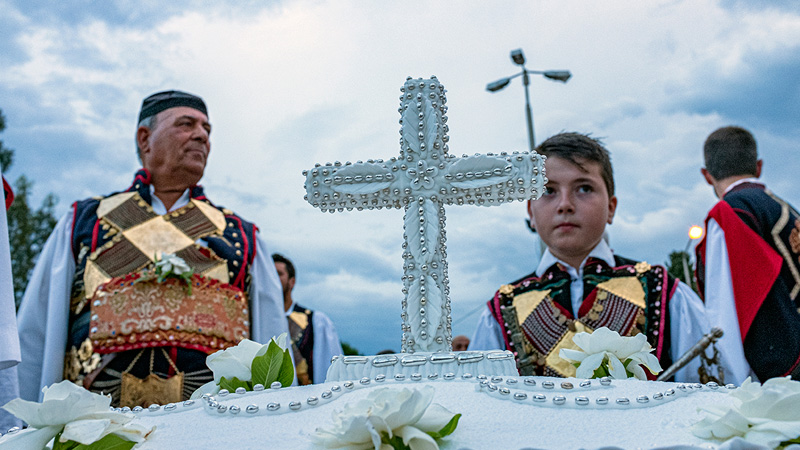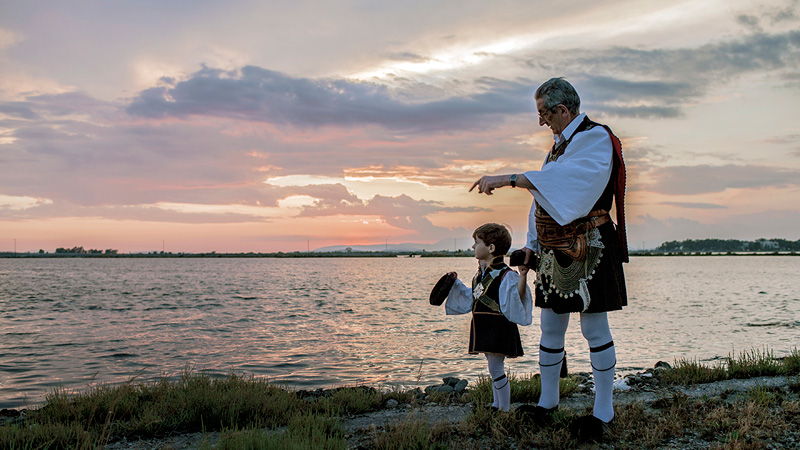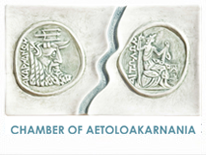 |
Τhe National Inventory of
|
|
The festival of Saint Symeon’s (t’Ai-Symiou) is a custom with historical, religious, musical and dance dimensions which takes place twice a year in Mesologgi: – on the 2nd & 3rd of February (Ypapadi) – on the four-day celebration of the Holy Spirit (Saturday to Tuesday- usually in June). It is one of the biggest celebrations of Messolonghi and it constitutes one of the most significant and notable happenings in the region of Aetolia. It was inscribed on the National Inventory of Intangible Cultural Heritage of Greece in 2018.
Photos (additional photos for the element available at the website: “THE JOHN D. PHOTOGRAPHY EXPERIENCE” The feast is inextricably bound with the Monastery of Saint Symeon, which is built at the foot of Arakynthos Mountain, at an altitude of 140 m., and dates from 1740. Following the events of the Exodus of Messolonghi, in 1826, and the founding of the Greek state, the feast has taken on a new character,now including amongst its rituals the memorial service for all those who fell during the Siege of Messolonghi. The Feast of Ai Symios, in honour of the holy man Ai Symios (Saint Symeon), takes place twice annually: On 2 and 3 February, day of the Presentation of Christ at the Temple (Candlemas) and Saint Symeon’s day, the so-called winter or women’s feast takes place. It is referred to as women’s due to the fact that in the past, it was attended mainly by women, who were fulfilling vows, with their children. On the first day of the winter feast, participants, in groups, go up to the monastery, where they celebrate in the evening at their usual hangouts. The following day, at noon, following the service held at the monastery, merrymaking continues until the afternoon. Later on, the crowds gather outside the town gate and return together to continue their merrymaking in town.
The feast begins, officially, on the Saturday before Pentecost, when all the groups of companions celebrate in their usual hangouts about town. On Sunday morning, each Captain sets off, roaming the town alleyways, where he gathers his companions. By noon, they have all gathered to feast on the traditional giouvetsi. By Sunday afternoon, all groups of companions have gathered at St. Spyridon’s Cathedral, from where they proceed, in procession, towards the Garden of Heroes, where the memorial service is held to commemorate all those who fell in the Exodus. The groups then set off from the Garden of Heroes towards the Monastery of Ai Symios. They arrive, dancing, up to a certain point, from where they continue to the monastery along a ten-kilometre route. In the past, they would ride to the monastery on horseback. Nowadays, cars are mainly used, although some revelers still ride up on horseback. The feast continues all night at the monastery until the early morning hours. On Monday morning, Holy Mass is held, and Roma/Romani arrive from all over Greece, to christen their children. After the service, the festivities continue until lunchtime, when the groups of companions begin their descent towards Messolonghi. On Monday afternoon, having gathered in the Agios Athanasios area, the big procession of Ai-Symiotes sets off for the centre of Messolonghi, ending up at Saint Spyridon. First the groups of armed men [αρματωμένοι – armatomenoi], then of horse-riders enter the town, singing and dancing until they reach their hangouts and continue their revelries all night. On Tuesday afternoon, after the memorial service has been held in the chapel of the Holy Trinity, on the islet of Kleisova, in honour of those who fell in the battle of that name (25 March 1826), the revelers return to their usual hangouts for their final merrymaking. The revelers, who are the soul of the feast, are divided into armed men [αρματωμένοι – armatomenoi] and horse-riders [καβαλαραίοι – kavalareoi], who are further divided into groups, the parees. As documented in the writings of Andreas Karkavitsas, the parees (companions). In older times, were also called mages [μάγκες]. It is said that the armed men [armatomenoi] go “dressed”, because they wear the traditional costumes and their arms, while the horse-riders [kavalareoi] go on horse-back because they go up to the monastery in mounted procession. Each group of companions has its chief, the so-called captain (or, in older times the boulouktsi), who is first among equals. If the armed men and the horse-riders are thought of as the soul of the feast, the zygia (band) is what creates spiritual ecstasy that characterizes the Ai-Symiotes. The zygia is the three-member band (trio) which accompanies each group, and consists of two zourna pipes or trumpets or bagpipes and a daouli [davouli or xerodaoulo – davul drum]. Traditionally, the zygia is trio (three-member band) which consists of Greek Roma, who, in the past, originated almost exclusively from Messolonghi and the surrounding region. The most important characteristic of a parea [παρέα – group of companions] is cooperation and solidarity amongst the members, and with the zygia during the feast. Furthermore, all those factors which differentiate social hierarchies are annulled, as they all are equal and there is no distinction between revelers from Messolonghi and Roma musicians. It is worth noting that on Holy Spirit Monday, many celebrants christen Roma children at Ai Symios monastery. An element of the utmost importance is the transmission, from one generation to the next, of the special manner of singing [«τραγούδισμα» – “tragoudisma”) and the particular manner of social behaviour, as they emerge through the performance of specific dances. During the feast, besides old folk table songs, kleft songs [κλέφτικα -kleftika] and lianotragouda [λιανοτράγουδα], merrymakers also sing famous moirologia [μοιρολόγια – dirges] of Messolonghi, songs about the siege of the town, as well as aisymiotika [αησυμιώτικα – Songs of Ai Symios]. The revelers’ dances, besides the tsamiko [τσάμικο] and the syrto [συρτό] dances, include the special local dances of the feast, such as Chelaki [Χελάκ – Little eel ], Tripsimo tou Piperiou [Τρίψιμο του Πιπεριού – Grinding of the Pepper] and the famous Choros tou pethamenou [Χορόs του Πεθαμένου – Dead man’s dance]. This last dance is the most characteristic representation: the dance starts from a misunderstanding between the captain and one of his companions, when the latter orders the music to stop. After some movements representing a fight, the captain wounds his companion, killing him. Later, realizing what he has done, he bends over the dead man, weeps and repents. Immediately, the Saint performs his miracle and the dead man is resurrected and rises, in even greater spirits, leading the dance with the captain and all his other companions. Also, very characteristic is the “throwing” of bank notes (from 2002 onwards it’s dollars) by the companions to the zygia musicians or their fellow revelers. In this symbolic manner, the Ai-Symiotes achieve the transition from the material world, to the spiritual ecstasy one is led to by the sounds of the zygia. It expresses the salvation of the reveler, his disdain for material goods and the exaltation achieved through spiritual/ethical values. The feast is inextricably bound with the Monastery of Saint Symeon, which is built at the foot of Arakynthos Mountain, at an altitude of 140 m., and dates from 1740. Following the events of the Exodus of Messolonghi, in 1826, and the founding of the Greek state, the feast has taken on a new character,now including amongst its rituals the memorial service for all those who fell during the Siege of Messolonghi. The Feast of Ai Symios, in honour of the holy man Ai Symios (Saint Symeon), takes place twice annually: On 2 and 3 February, day of the Presentation of Christ at the Temple (Candlemas) and Saint Symeon’s day, the so-called winter or women’s feast takes place. It is referred to as women’s due to the fact that in the past, it was attended mainly by women, who were fulfilling vows, with their children. On the first day of the winter feast, participants, in groups, go up to the monastery, where they celebrate in the evening at their usual hangouts. The following day, at noon, following the service held at the monastery, merrymaking continues until the afternoon. Later on, the crowds gather outside the town gate and return together to continue their merrymaking in town. Over the three-day holiday of Pentecost (Sunday), the Holy Spirit (Monday) and the Holy Trinity (Tuesday), the so-called summer feast. or feast of the armed men, is held. The summer feast, which is the better known one, is the second largest event in the town, following the “Exodus Celebrations”, and has all the characteristics of a large popular religious and historical celebration. Celebrations start as early as Ascension day (about ten days before Pentecost), when the first “trial” gathering of all the groups takes place, which is, of course, followed by merry-making. The feast begins, officially, on the Saturday before Pentecost, when all the groups of companions celebrate in their usual hangouts about town. On Sunday morning, each Captain sets off, roaming the town alleyways, where he gathers his companions. By noon, they have all gathered to feast on the traditional giouvetsi. By Sunday afternoon, all groups of companions have gathered at St. Spyridon’s Cathedral, from where they proceed, in procession, towards the Garden of Heroes, where the memorial service is held to commemorate all those who fell in the Exodus. The groups then set off from the Garden of Heroes towards the Monastery of Ai Symios. They arrive, dancing, up to a certain point, from where they continue to the monastery along a ten-kilometre route. In the past, they would ride to the monastery on horseback. Nowadays, cars are mainly used, although some revelers still ride up on horseback. The feast continues all night at the monastery until the early morning hours. On Monday morning, Holy Mass is held, and Roma/Romani arrive from all over Greece, to christen their children. After the service, the festivities continue until lunchtime, when the groups of companions begin their descent towards Messolonghi. On Monday afternoon, having gathered in the Agios Athanasios area, the big procession of Ai-Symiotes sets off for the centre of Messolonghi, ending up at Saint Spyridon. First the groups of armed men [αρματωμένοι – armatomenoi], then of horse-riders enter the town, singing and dancing until they reach their hangouts and continue their revelries all night. On Tuesday afternoon, after the memorial service has been held in the chapel of the Holy Trinity, on the islet of Kleisova, in honour of those who fell in the battle of that name (25 March 1826), the revelers return to their usual hangouts for their final merrymaking. The revelers, who are the soul of the feast, are divided into armed men [αρματωμένοι – armatomenoi] and horse-riders [καβαλαραίοι – kavalareoi], who are further divided into groups, the parees. As documented in the writings of Andreas Karkavitsas, the parees (companions). In older times, were also called mages [μάγκες]. It is said that the armed men [armatomenoi] go “dressed”, because they wear the traditional costumes and their arms, while the horse-riders [kavalareoi] go on horse-back because they go up to the monastery in mounted procession. Each group of companions has its chief, the so-called captain (or, in older times the boulouktsi), who is first among equals. If the armed men and the horse-riders are thought of as the soul of the feast, the zygia (band) is what creates spiritual ecstasy that characterizes the Ai-Symiotes. The zygia is the three-member band (trio) which accompanies each group, and consists of two zourna pipes or trumpets or bagpipes and a daouli [davouli or xerodaoulo – davul drum]. Traditionally, the zygia is trio (three-member band) which consists of Greek Roma, who, in the past, originated almost exclusively from Messolonghi and the surrounding region. The most important characteristic of a parea [παρέα – group of companions] is cooperation and solidarity amongst the members, and with the zygia during the feast. Furthermore, all those factors which differentiate social hierarchies are annulled, as they all are equal and there is no distinction between revelers from Messolonghi and Roma musicians. It is worth noting that on Holy Spirit Monday, many celebrants christen Roma children at Ai Symios monastery. An element of the utmost importance is the transmission, from one generation to the next, of the special manner of singing [«τραγούδισμα» – “tragoudisma”) and the particular manner of social behaviour, as they emerge through the performance of specific dances. During the feast, besides old folk table songs, kleft songs [κλέφτικα -kleftika] and lianotragouda [λιανοτράγουδα], merrymakers also sing famous moirologia [μοιρολόγια – dirges] of Messolonghi, songs about the siege of the town, as well as aisymiotika [αησυμιώτικα – Songs of Ai Symios]. The revelers’ dances, besides the tsamiko [τσάμικο] and the syrto [συρτό] dances, include the special local dances of the feast, such as Chelaki [Χελάκ – Little eel ], Tripsimo tou Piperiou [Τρίψιμο του Πιπεριού – Grinding of the Pepper] and the famous Choros tou pethamenou [Χορόs του Πεθαμένου – Dead man’s dance]. This last dance is the most characteristic representation: the dance starts from a misunderstanding between the captain and one of his companions, when the latter orders the music to stop. After some movements representing a fight, the captain wounds his companion, killing him. Later, realizing what he has done, he bends over the dead man, weeps and repents. Immediately, the Saint performs his miracle and the dead man is resurrected and rises, in even greater spirits, leading the dance with the captain and all his other companions. Also, very characteristic is the “throwing” of bank notes (from 2002 onwards it’s dollars) by the companions to the zygia musicians or their fellow revelers. In this symbolic manner, the Ai-Symiotes achieve the transition from the material world, to the spiritual ecstasy one is led to by the sounds of the zygia. It expresses the salvation of the reveler, his disdain for material goods and the exaltation achieved through spiritual/ethical values.
The locations connected to the celebration of the feast are: 1) St. Symeon’s monastery and its grounds, with permanent installations and stalls. Each group of companions have their own space, either a stall or building. 2) The main streets of the town of Messolonghi for the processions of the Ai-Symiotes and the hangouts of the groups in the town’s alleys. Each group of companions, over time, has determined a specific space in the town centre, where they make merry every year. 3) The houses of the revelers themselves, where the captains pass by to gather the entire group of companions. At every house, relatives make a point of offering the captain and the other companions all sorts of savoury and sweet delicacies, as well as the traditional ouzo. 4) The Garden of Heroes, where the Pentecost procession ends, and where the memorial service is held to pay tribute to all deceased Ai-Symiotes.
The facilities connected to the performance of the custom are the following: 1) The headquarters of “Ai Symios” Society, where various heirlooms (photographs, banners, documents) are kept; these premises are also used for gatherings of the Board of Directors and for decision making. 2) The grounds of Saint Symeon’s monastery where, for decades, there have been dedicated spaces or buildings for each group of companions. This is where the groups keep all necessary equipment before each gathering and revelry. Unfortunately, there are still groups who have not managed to build their own stone or wooden building and are confined to spots in nature surrounding the monastery. nature, During the winter months, these are protected by plastic coverings. 3) In addition, the “Diexodos” historical museum houses the heirlooms which are directly connected with the feast. In an effort to highlight and promote it, “Diexodos” has incorporated in the historical museum’s permanent collection, a series of photographs
READ MORE
Online resources (hyperlinks)
Information about the songs of the item:
Photos from the festival Documentaries and films that refer to the festival or contain snapshots from it: 1) Lake of Desires (1958), a short excerpt from the film has footage from the festival.. 2) Shots by Costas Balafas of 1968. 3) Excerpt from an ERT archive of 1976. 4) "To Ai Symios in Messolonghi", ERT's musical journey of Takis Sakellariou, 1996. 6) "We live in Greece", excerpts from the festival of 2005. 7) "Greek Events", a tribute to the festival, 2006. 8) "Dollars for a Saint", the documentary about the Roma organ players of the festival, by Aura Georgiou, 2014. |
Source: |
 |
INTANGIBLE CULTURAL HERITAGE of UNESCO |









